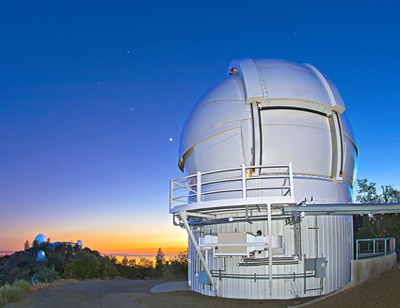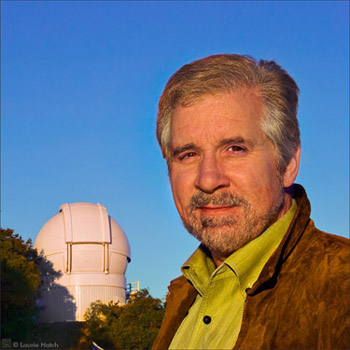Campus News
Lick’s Automated Planet Finder: First robotic telescope for planet hunters
In its first months of operation, the APF has found two new planetary systems, giving astronomers a taste of planetary riches to come

2150_APFVenusSunset © 2007 Laurie Hatch, image and text – Lick Observatory – Mt. Hamilton – 2007 June 16 – AUTOMATED PLANET FINDER TELESCOPE – The newly constructed 2.4-meter APF is framed by a darkening sky, the bright planet Venus, the Lick Observatory Main Building, and the glow of city lights from Silicon Valley. Fully robotic and equipped with a high-resolution spectrograph optimized for precision Doppler measurements, it will enable off-site astronomers to detect rocky planets of Earth-size masses within our local galactic neighborhood. – The photographer thanks APF and UCO/Lick staff for their invaluable assistance in producing this photograph. – A VIEW FROM LICK OBSERVATORY – Lick Observatory crowns the 4,200-foot Mt. Hamilton summit above Silicon Valley in central California. This research station serves astronomers from University of California campuses and their collaborators worldwide. Eccentric Bay Area tycoon and philanthropist James Lick (1796-1876) bequeathed funding for construction which spanned from 1880 to 1887, fulfilling his vision of the Observatory as a premier astronomical facility. In 1959, the Shane 3-meter reflecting telescope was completed on Mt. Hamilton. It continues to provide data for forefront research and engineering programs. In total, the mountain top is home to ten telescopes which are supported by resident staff and by headquarters at UC Santa Cruz. Acclaimed for academic excellence, technical expertise, and superior instrumentation, Lick Observatory probes the expanding frontiers of space. – Exposure data: Nikon D2x Nikkor 10.5mm DX f/2.8 fisheye lens ISO digital: 100 / f/5.6 Exposure: 30 seconds – For more information: http://exoplanets.org/rpf.html, http://www.ucolick.org/public/telescopes/apf.html, lh@lauriehatch.com, http://www.lauriehatch.com

Lick Observatory’s newest telescope, the Automated Planet Finder (APF), has been operating robotically night after night on Mt. Hamilton since January, searching nearby stars for Earth-sized planets. Every night the fully autonomous system checks the weather, decides which stars to observe, and moves the telescope from star to star throughout the night, collecting measurements that will reveal the presence of planets. Its technical performance has been outstanding, making it not only the first robotic planet-finding facility but also one of the most sensitive.
The search for planets beyond our solar system (called “extrasolar planets” or “exoplanets”) has yielded a huge number of discoveries in recent years, especially since NASA’s Kepler spacecraft joined ground-based telescopes in the effort. Unlike Kepler, however, which focused on distant stars in one small patch of sky, the APF focuses on nearby stars and covers the entire sky.
“The planetary systems we’re finding are our nearest neighbors. Those are the ones that will matter to future generations,” said Steve Vogt, professor of astronomy and astrophysics at UC Santa Cruz, who led the $12 million APF project and designed the Levy spectrometer at the heart of the system.
Vogt said it was a long and difficult road to get the APF facility completed, but now that it’s up and running he couldn’t be happier with its performance. Project manager and principal engineer Matthew Radovan of UC Observatories (UCO) oversaw a large team of UCO technical staff who provided crucial support for the construction and commissioning of the APF facility.
Sandra Faber, interim director of UC Observatories, said she was “absolutely thrilled” at the success of the APF. “Our UCO staff worked incredibly hard during the past year to get the new facility on the air. The APF is living proof that older observatory sites like Lick, which has been working for over 125 years, can still produce cutting-edge science,” said Faber, a University professor of astronomy and astrophysics at UC Santa Cruz.
Vogt’s team has submitted two papers describing new planetary systems recently discovered by the APF. A paper on the APF itself, with a full description of the system and details on how well it is performing, will be published April 1 in Publications of the Astronomical Society of the Pacific (available online at arXiv.org).
Optimized for planet hunting
The APF facility consists of a 2.4-meter telescope and the Levy Spectrometer, which Vogt designed and optimized specifically for planet hunting. The spectrometer takes starlight from the telescope and spreads it into a rainbow of colors, splitting the light into a spectrum of thousands of different wavelengths that can be measured with great precision. Repeated measurement of a star’s spectrum enables astronomers to detect the tiny wobble induced in a star by the gravitational tug of an orbiting planet. The Levy Spectrometer was named in recognition of a gift to support its construction from the Gloria and Kenneth Levy Foundation.
“Steve Vogt has a long history of breaking barriers in the design and construction of the world’s most sensitive and precise spectrometers. This time, he has outdone himself,” said APF co-investigator Geoffrey Marcy, professor of astronomy at UC Berkeley. “With the Automated Planet Finder, he has not only built a highly efficient and precise planet-hunting spectrometer, but he also led the construction of the world’s first robotic telescope tuned finely enough to feed such a spectrometer.”
Greg Laughlin, professor and chair of astronomy and astrophysics at UCSC, said the APF is a world-class facility perfectly suited to detecting planets in our neighborhood of the galaxy. Laughlin and his students (primarily Stefano Meschiari, now at the University of Texas, Austin) developed the software package, called Systemic Console, that researchers use to pull planet discoveries out of the data acquired by the APF and other telescopes.
“The vast majority of planets reveal themselves over time through a series of measurements, and the signals are buried in the huge stream of data that comes back from the telescope every night, so this software package is an integral part of the detection process,” Laughlin said. “APF is the best current planet-finding instrument that can see the sky above our hemisphere. It’s remarkable that this cutting-edge research can be done within sight of Silicon Valley–you don’t have to go to Hawaii or Chile.”
Vogt also designed spectrometers for the Keck I Telescope in Hawaii and Lick’s Shane Telescope–both of which have been highly productive planet-finding instruments. In many ways, however, the APF is a more powerful planet finder than even the 10-meter Keck telescope because the APF was custom-built for that purpose, Vogt said. The precision with which the APF can measure the motion of a star is much better than can be achieved at Keck. The APF’s telescope is relatively small, but with modern optical technology, including special coatings on the mirrors, its optical efficiency is very high.
“We can do the same work we did at Keck, except now we have the APF every night instead of just a few nights per month at Keck,” Vogt said. “What we’re learning from all of this–from Kepler and from our own work–is that there’s a huge number of planets out there, more planets than there are stars, and they’re everywhere, including right next door to us.”
The first two planetary systems detected by the APF were initially suspected based on data Vogt’s team got at Keck, but were only confirmed after repeated observations with the APF. One of the systems (HD 141399) consists of four gas giant planets, similar to the four gas giants in our solar system except that their orbits are much closer to their star. The other system (GJ 687) features a Neptune-mass planet orbiting a red dwarf star. These are “garden variety systems,” not dramatic discoveries, Vogt said. But APF has the sensitivity to detect the ultimate goal–an Earth-sized planet orbiting a nearby star in the habitable zone, where it is neither too hot nor too cold for liquid water on the planet’s surface.
“APF will be a marvelous facility for finding potentially habitable Earth-sized planets around our nearest stellar neighbors,” said Vogt’s longtime collaborator Paul Butler of the Carnegie Institution of Washington.
The APF will also be useful for a wide range of conventional astronomical observations involving spectroscopy, including follow-up observations of bright supernova explosions and gamma-ray bursts that may brighten and dim quickly. “The robotic APF can wheel over to these stupendous cosmic explosions within seconds to allow spectroscopic analysis of their brilliant flash of light,” Marcy said.
About 20 percent of the APF’s time is set aside for purposes other than planet finding, with access to be allocated by the director of UC Observatories. The rest of the observing time is divided equally between the planet search teams led by Vogt and Marcy.
Funding for the APF came from several sources, including $6.4 million in Congressional ear-mark funding through the U.S. Naval Observatory. Additional funding was provided by grants from NASA and the National Science Foundation, as well as gifts from several private donors.